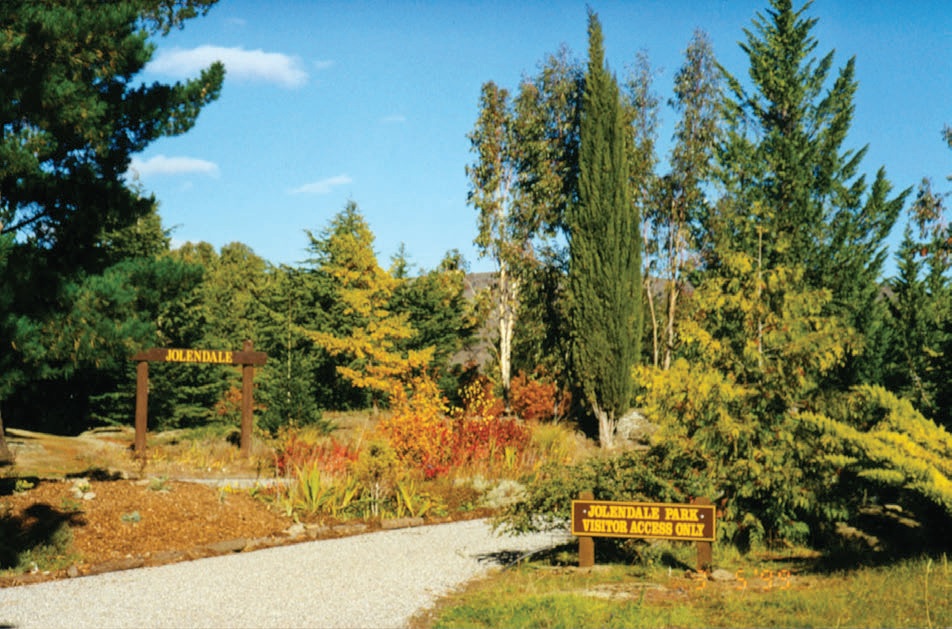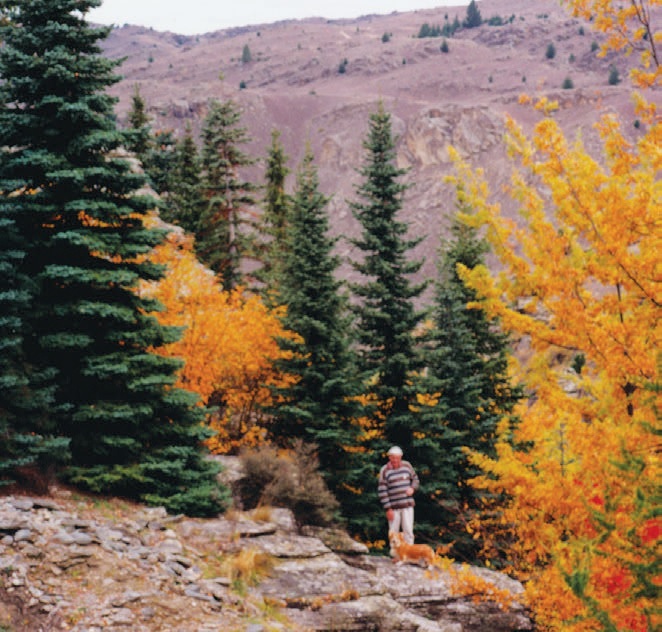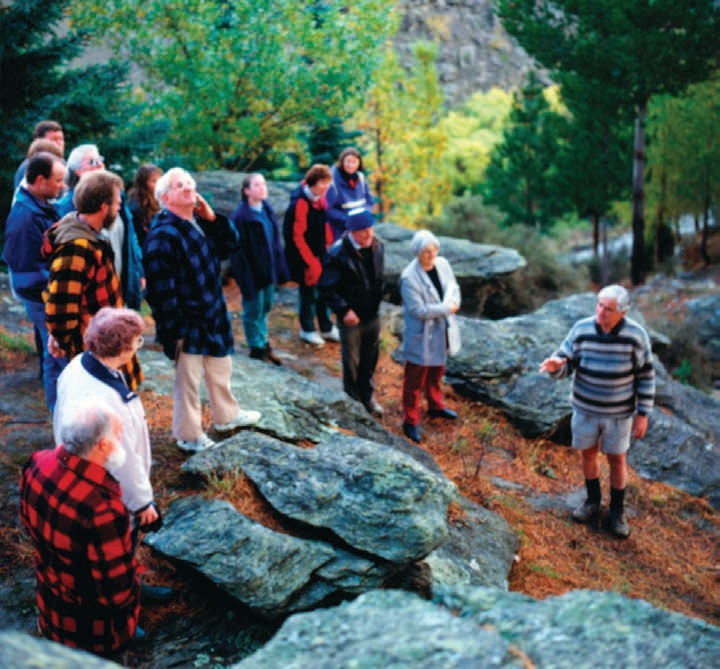A tree planter’s dreams and visions - Jolendale Park
Jolyon Manning, New Zealand Tree Grower November 2009.
It is now approaching 50 years since my wife Enny Manning and I first began our experimental dryland tree planting as a research project − a six hectare block at the top of Bridge Hill, Alexandra. We are in the process of gifting outright the well endowed parkland to the Central Otago District Council on behalf of the Central Otago community.
The art of the long view
This is the driest ecological district in New Zealand, and in 2004 permanent protection was secured with the sponsorship of a QEII Trust for Open Space covenant as the sole ‘semi- arid woodland reserve’ in New Zealand.
Initially Jolendale Park was established as a base for dryland experimental tree planting research. Today this unique setting is becoming a semi-natural place for the daily enjoyment of local township residents and tree loving visitors from elsewhere hoping to understand something of our unique Otago schist rock landscapes. Jolendale Park continues as a focus for an evolving family dream and vision, and community giftedness.
In the past 50 years there have been huge changes in our western world culture and in spiritual pursuits and religious disciplines. As the timeline has contracted there has been an increasing focus on earlier neglected patterns of conservation and sustainability, climate change and pollution of the primary elements of soil, water and atmosphere.
Succession planning has become a timely topic with farmers, who have often in the past inherited and passed on family farms in an unbroken cycle of ownership for generations. They now more readily switch to new avenues of employment and lifestyle residence.

Professor Charles Handy has some words of wisdom concerning the life cycle sigmoid curve which he presented in a most illuminating book The Empty Raincoat – making sense of the future which I would recommend.
Shelter and homestead tree planting

When the NZFFA was established more than half a century ago the tree planting accent was placed on farm shelter, woodlot timber production and homestead amenity. For many these still remain the central goals. But the magnet of the urban workplace and living has captured a high ratio of the young people brought up on the family farm. Tertiary education, now available to many, specialist professional vocation and overseas travel are now more freely available, and the hard working farm life has become more remote.
One of the lessons we all learn from our more exuberant early days of tree and shrub planting is the question of essential regular follow-up maintenance. It is easy in a freshly planted zone with its natural package of micro-nutrients to freely celebrate with others the spectacular ‘instant’ glamour of new trees and plants but more challenging to maintain the show for the enjoyment of others. I am a strong advocate of fish and seaweed fertiliser.
There are now spread throughout New Zealand some wonderful woodlots and remnant natural landscape remnants with a greater diversity of species. This in spite of the challenging economic times we now face and thanks in no small measure to the NZFFA and QEII National Trust.
A couple of decades ago Brian Molloy presented a paper to the NZ Ecological Association. This highlighted the need in New Zealand to more actively promote ‘semi-natural’ landscapes, allowing for a more flexible mixture of indigenous and introduced selection of suitable trees and shrubs that might enhance biodiversity. A year ago Ian Barton prepared a most useful handbook for the management of New Zealand forests Continuous Cover Forestry under the auspices of the Tane’s Tree Trust.
NeighbourWoods and city dwellers
This year the Danish Centre for Forest, Landscape and Planning, has prepared a most timely booklet NeighbourWoods for Better Cities. Long overdue emphasis is placed on multifunctional woods immediately accessible to the where people live and work – in the built up cities and rural townships. As the authors say, ‘such urban woodlands are a primary means of keeping city dwellers in touch with nature and natural processes. These woods can offer pleasant environments for rest, relaxation and recreation’.
Farm foresters can play an important role in sharing their homestead and woodlot experiences with a wider public now more commonly living in our towns and cities. More and more people who have earned good incomes in the cities are now moving out into our open countryside landscapes with large properties and luxurious mansions. They can learn from our farm forestry movement’s half century experience.
Climate change and critical thresholds
Today we are all talking about climate change and global warming, mounting atmospheric pollution and sustainable land, soil and water values. Generally in New Zealand we enjoy a relatively benign climate but this can be seriously disrupted economically and socially with the challenging seasonal frost, excessive flood and sustained drought. When such events follow in close succession, this can lead to disaster for the land stakeholder.
I have taken a personal interest in climate change and the possible relationship with sunspot cycles for the past 50 years. I have mapped out the apparent association of persistent major flood events in the very large Clutha and Waitaki catchments on the occasion of rapidly rising phase of the 11-year cycle.
 We are at the present time witnessing the most extended period of relative absence of these disturbances on the Sun’s surface – known as the ‘quiet sun’ that occurs between successive cycles – for more than a century.
We are at the present time witnessing the most extended period of relative absence of these disturbances on the Sun’s surface – known as the ‘quiet sun’ that occurs between successive cycles – for more than a century.
I still very much regret the untimely demise of the former New Zealand Forest Service and will long remember the wise words of the late Lindsay Poole. I know from my lifetime professional experience in regional development and the many aspects of the forestry and horticultural sector what a virtual irreplaceable gap this has left in our nation’s agenda.
Like Lindsay, I have a profound faith in the continued good work of the NZFFA. We at Jolendale Park will always most warmly welcome members from time to time. The park is always open for visitors and especially for those who have a specialist interest in forestry and the associated sciences and arts. And for the present day tree planters, keep planting and remember the Maori saying, ‘Aloof at planting but friendly at the time of harvest’.
Visit us around Conference time
We have enjoyed a lifetime association with the NZFFA and members and have from time to time hosted members on special field days. It is not practicable to include a Jolendale Park visit amongst the formal field day programme at the Invercargill conference in April.
However we would like to offer a day of jubilee celebration either immediately before or immediately following the conference timetable to enable our more distant farm forestry friends to enjoy an update and some hospitality on the occasion of the jubilee.

 Farm Forestry New Zealand
Farm Forestry New Zealand